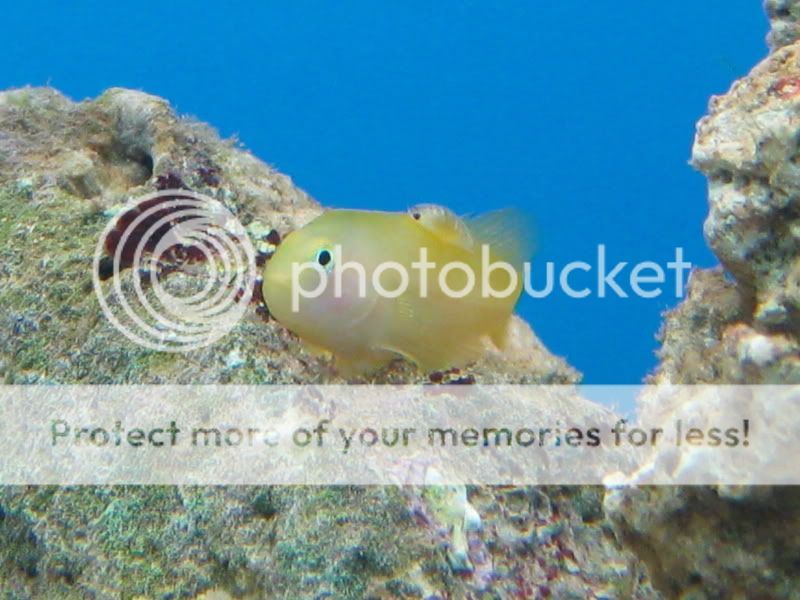OMG
Found this by Ron Shimek :
I am writing a book about aquarium inverts - here is what I had to say about cirolanids in the manuscript. You might want to watch your tank. You may have more than one of them in it.
If reef bugs could talk, they might well nominate Cirolanid isopod as the "bug's bug." Some of these may be relatively large isopods, reaching eight or nine centimeters long and about a centimeter wide. Most we seen in aquaria are about one tenth as large. They have a pointed front end, a streamlined tapered body, short antennae and big eyes on the front of the head. They generally are colored white or a mottle gray to match the substrate.
Unlike their wimpy herbivorous cousins, these isopods are not afraid of fish. On the contrary, they consider them a tasty delicacy...
Cirolanids are often considered to be parasites, but this term is relative and may be applied to a small predator that just eats a bit of its larger prey over time. Large Cirolanid isopods in the north eastern Pacific have been seen to wait on the bottom until an acceptable fish, such as a small salmon, swims overhead. The isopod then swims rapidly up and fastens on to the fish, and proceeds to eat its fins and tail. The bug then slices open the fish and eats all its blood, proceeding then to eat the lateral muscle bands and when they are done they discard the guts and skeleton.
Parasite, indeed!
The same species will fasten on to larger fish and eat its way into a major blood vessel where it will remain for some time sucking blood and eating tissue. When sated it will detach from the host and swim away.
Tropical species not infrequently show up in reef tanks either riding on a fish or in a piece of live rock. Often the first the aquarist knows of them is when they see the isopod on a fish. Murphy's law is active here; the bug will never be on a cheap or expendable fish. The problem is how to remove the isopod from the aquarium. If the bug stays on the fish, the fish needs to be captured. Now, this happened to me, and the fish it was on was a Mandarinfish. Imagine trying to catch this fish in a fully set up 100 gallon aquarium. Right. Of course, I couldn't catch the fish! I actually did catch the fish the next day, and the isopod was still on him. There wasn't much left of the fish. Even I can catch a fish that is half eaten.
If YOU can catch the fish, the isopod may be removed with a pair of forceps. Carefully!!! Upon removal the fish should be isolated in hospital tank, and treated with antibiotics until the wound heals. The bug may be disposed of. Carefully!!! I had a student who was holding a three centimeter cirolanid that we had just collected in her clenched hand. The bug cut through the flesh of her palm, dug in, and started to eat HER. Her response was rather impressive. So was the tenacity of the isopod, it was HARD to remove it. After so much hard work, by the way, I insisted we release the bug, that much initiative deserved to be rewarded.
If you notice a cirolanid in your tank, and it leaves the fish, there is almost nothing that may be done to catch it. They are very fast, small, and quite capable of avoiding a net. And if it is a pregnant female (remember all isopods have brood pouches), and the brood hatches, you have REAL problems. There are only three courses of action in this situation; and I truly am not jesting about these responses. The first is to remove all the fish from the tank and wait the two or three months until you are certain that all the isopods have died from starvation. The second solution is to effectively nuke the tank. Remove all live rock and discard it as the isopods may hide in it, and as some of the isopods bury in the sand, you should also remove and discard the sand.
You may of course take the third option and do nothing. The most likely outcome in this situation will be that the isopods will kill your fish one by one. You may not even know they are attacking a fish until the fish is dead. Some years ago there were several large sharks that washed ashore in Florida. Examination showed that they were all killed by cirolanids that had burrowed into the shark and eaten their hearts.
Masterfully designed predators, these isopods. Hope fervently that you never have to deal with them.
Seffie x
ps so, get that little goby out, get the tweezers out and good luck

I wonder if they are like mites, if they are you should twist them as you are pulling them out eeekkk. Truck, do you have a small hospital tank?

























 I wonder if they are like mites, if they are you should twist them as you are pulling them out eeekkk. Truck, do you have a small hospital tank?
I wonder if they are like mites, if they are you should twist them as you are pulling them out eeekkk. Truck, do you have a small hospital tank?

 and pulling the pod apart
and pulling the pod apart
and pulling the pod apart



and pulling the pod apart

